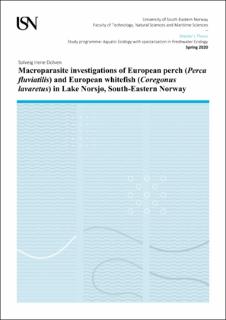Macroparasite investigations of European perch (Perca fluviatilis) and European whitefish (Coregonus lavaretus) in Lake Norsjø, South-Eastern Norway
Master thesis
Published version
Permanent lenke
https://hdl.handle.net/11250/2754457Utgivelsesdato
2020Metadata
Vis full innførselSamlinger
Sammendrag
In 2018, the abundance of macroscopic ectoparasites and intestinal endoparasites was investigated in European perch (Perca fluviatilis) and European whitefish (Coregonus lavaretus) collected in three seasons and three sites from Lake Norsjø, South-Eastern Norway. The main objectives were to reveal factors known to affect freshwater parasite abundance in fish, like host specificity, season, water temperature, habitat, diet, fish length and age. Totally 2113 parasite individuals were found in the 258 perch and 101 whitefish investigated. The most abundant parasites found in both species were acanthocephalans and Proteocephalus spp., constituting 95 % of the total parasite load. The remaining 5 % were individuals of Triaenophorus crassus, Dibothriocephalus spp., nematodes, trematodes, Salmincola sp. and Argulus coregoni in European whitefish, and Triaenophorus crassus, Triaenophorus nodulosus, Dibothriocephalus spp., Eubothrium sp., nematodes and Argulus coregoni in European perch.
Significantly higher abundance of Proteocephalus spp. was found in whitefish than in perch, while significantly higher abundance of acanthocephalans was found in perch. This indicates differences in fish diet, as acanthocephalans are transmitted by benthic macroinvertebrates, while Proteocephalus spp. are transmitted by pelagic copepods. Furthermore, the cestode fauna was more diverse in perch than in whitefish. The most important parasite predictors were fish length and season. The abundance of acanthocephalans in both fish species, Proteocephalus sp.1 in whitefish, and cestodes in perch, all increased significantly by increasing fish length. This is likely a consequence of longer time feeding histories and need of more food and more diverse food, in increasingly larger and older fish. Acanthocephalans were significantly less abundant in autumn than spring in both fish species, while in perch these parasites were significantly more abundant in summer than in spring. Proteocephalus sp.1 was significantly more abundant in summer and autumn than in spring in whitefish, while Proteocephalus sp.2 of perch was found only in spring. The different seasonalities are likely effects of various life cycles among the parasite species in the lake.
